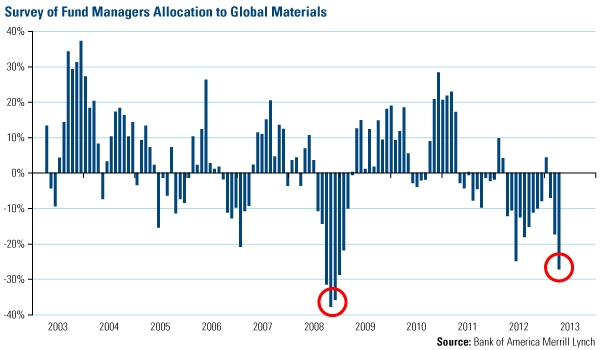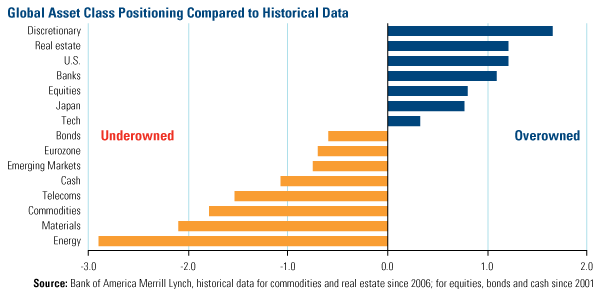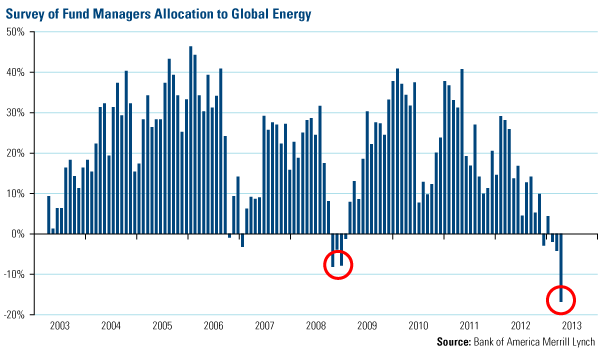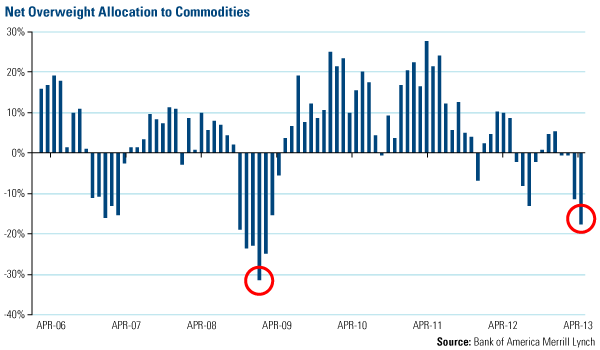A Case for Owning Commodities When No One Else Is
Published in on May 1, 2013
By Frank Holmes 
View Original Article Here
Sometimes following where money is being invested is a solid course of action to gain alpha; other times, a better opportunity lies in going the opposite direction, i.e., thinking contrarian.
Take commodities, energy and materials, which may be the most unappreciated areas of the market these days. According to Bank of America Merrill Lynch’s Global Fund Manager Survey of 250 participants who collectively manage $725 billion, energy, materials and commodities are extremely underowned.
As you can see below, the global asset class positioning during the first week of April compared to historical data shows that energy positions are close to 3 standard deviations below the long-term average. An allocation to materials is more than 2 standard deviations below its long-term average and commodity exposure is close to 2 standard deviations below its historical measure.
Take note of the timing, though, as it appears that it may make sense to own the most underowned areas of the market. Compare today’s portfolio weightings to the last time fund managers had such a significant underweight in these asset classes. Each bar below indicates whether allocations in energy represented a net overweight or underweight position. Most of the time since 2003, managers maintained an overweight allocation, which means they likely anticipated outperformance in energy companies during this period of time.
However, the last time they had such a big underweight in global energy for this long was at the end of 2008 and the beginning of 2009.
In materials, there were many more times that managers chose to have an underweight allocation to the sector. But again, the magnitude of today’s allocation decision matches what we saw in the 2008-2009 timeframe.

A similar picture for commodities reveals this consistent trend. Asset allocation indicating an overweighting in commodities hasn’t been this negative since 2008-2009.
Given the historical trend in late 2008 and early 2009 when managers were invested in other areas of the market, many likely missed the huge rally in natural resources stocks. From the market bottom on March 9, 2009, the Morgan Stanley Commodity Related Equity Index of commodity stocks grew 156 percent on a cumulative basis over the next two years. This is more than twice the return of the commodities futures index, the Dow Jones-UBS Commodity Index.
Don’t miss the next potential rally. In one investment, the Global Resources Fund (PSPFX) gives you exposure to all three of these underowned segments of the market. It’s a multi-faceted approach to energy and materials stocks across 10 distinct industries to aim for lower volatility and better growth potential.
Don’t miss the next potential rally. In one investment, the Global Resources Fund (PSPFX) gives you exposure to all three of these underowned segments of the market. It’s a multi-faceted approach to energy and materials stocks across 10 distinct industries to aim for lower volatility and better growth potential.
We believe the commodity supercycle continues, driven by emerging countries experiencing rising urbanization, increasing wealth and healthy GDP growth rates. What’s important for investors to remember is to build a diversified basket of natural resources companies actively managed by professionals who understand the seasonal and cyclical trends of these specialized assets.
Please consider carefully a fund’s investment objectives, risks, charges and expenses. For this and other important information, obtain a fund prospectus by visiting www.usfunds.com or by calling 1-800-US-FUNDS (1-800-873-8637). Read it carefully before investing. Distributed by U.S. Global Brokerage, Inc.



Comments